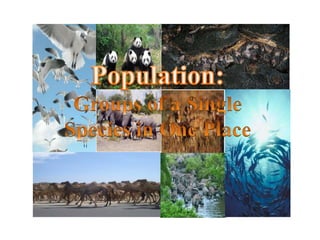
POPULATION: GROUP OF SINGLE SPECIES IN ONE PLACE
- 2. Population ecology is a sub-field of ecology that deals with the dynamics of species populations and how these populations interact with the environment. It is the study of how the population sizes of species living together in groups change over time and space. Population is a summation of all the organisms of the same group or species, who live in the same geographical area, and have the capability of interbreeding.
- 3. Three characteristics of population ecology are: 1. Population range, the area throughout which a population occurs 2. The pattern of spacing of individuals within that range 3. How the population changes in size through time.
- 4. A population’s geographic distribution is termed its range Range or distribution of a species is the geographical area within which that species can be found.
- 5. A population’s geographic distribution is termed its range Organisms must be adapted for the environment in which they occur. Each population has its own requirements – temperature, humidity, certain types of food, and a host of other factors – that determine where it can live and reproduce and where it can’t.
- 6. Ranges undergo expansion and contraction Population ranges are not static but change through time. Factors are, the environment changes like as climates warmed, species experienced in the elevation at which they could live. Population can expand their ranges when they are able to circumvent inhospitable habitat to colonize suitable, previously unoccupied areas.
- 7. 25° 221 _ 26° 131 _ 27° 151 _ 29° 90 _ 29° 189 _ 28° 254 _ 28° 279 _ 27° 422 _ 27° 403 _ 27° 412 _ 26° 354 _ 25° 322 _ Jan Feb Mar Apr May Jun Jul Aug Sep Oct Nov Dec Temperatures °C (degrees Celsius) in Manila Rainfall (mm) in Manil (Average values for each month)
- 8. Ranges undergo expansion and contraction The human effect Humans have served as an agent of dispersal for many species.
- 9. Ranges undergo expansion and contraction Dispersal Mechanism Seeds have evolved a number of different means of facilitating dispersal from their maternal plant. Some seeds can be transported great distances by the wind, whereas seeds enclosed in adherent or fleshy fruits can be transported by animals.
- 10. Individuals in populations exhibit different spacing patterns Spacing patterns are the distribution of a certain specie in a given area or an environment
- 11. Individuals in populations exhibit different spacing patterns Random Spacing Random spacing of individuals within population occurs when they do not interact strongly with one another and when they are not affected by nonuniform aspects of their environment. also known as unpredictable spacing
- 12. Individuals in populations exhibit different spacing patterns Uniform Spacing Uniform spacing within a population may often, but not always, result from competition for resources. also known as even distribution, or evenly spaced
- 13. Individuals in populations exhibit different spacing patterns Clumped Spacing Individuals clumped into groups or clusters in response to uneven distribution of resources in their immediate environments.
- 14. A metapopulation comprises distinct populations that may exchange members Metapopulation is when species often exist as a network of distinct populations that interact with one another by exchanging individuals, and usually occur in areas in which suitable habitat is patchily distributed and is separated by intervening stretches of unsuitable habitat.
- 15. The term metapopulation was coined by Richard Levins in 1970 to describe a model of population dynamics of insect pests in agricultural fields, but the idea has been most broadly applied to species in naturally or artificially fragmented habitats. In Levins' own words, it consists of "a population of populations". A metapopulation comprises distinct populations that may exchange members
- 16. A metapopulation comprises distinct populations that may exchange members Dispersal and habitat occupancy The degree to which populations within a metapopulation interact depends on the amount of dispersal; this interaction is often not symmetrical: Populations increasing in size tend to send out many dispersers, whereas populations at low levels tend to receive more immigrants than they send off. In addition, relatively isolated populations tends to receive relatively few arrivals.
- 17. A metapopulation comprises distinct populations that may exchange members Source-sink metapopulations The populations in the better areas, (the sources) continually send out dispersers that bolster the populations in the poorer habitats (the sinks). In he absence od such continual replenishment, the sink populations would have a negative growth rate and would eventually become extinct.
- 18. A metapopulation comprises distinct populations that may exchange members Metapopulation has two important implications for the range of species, it prevents long term extinction and in source-sink metapopulations, the species occupies a larger area than it otherwise might, including marginal areas that could not support a population without a continual influx of immigrants.
